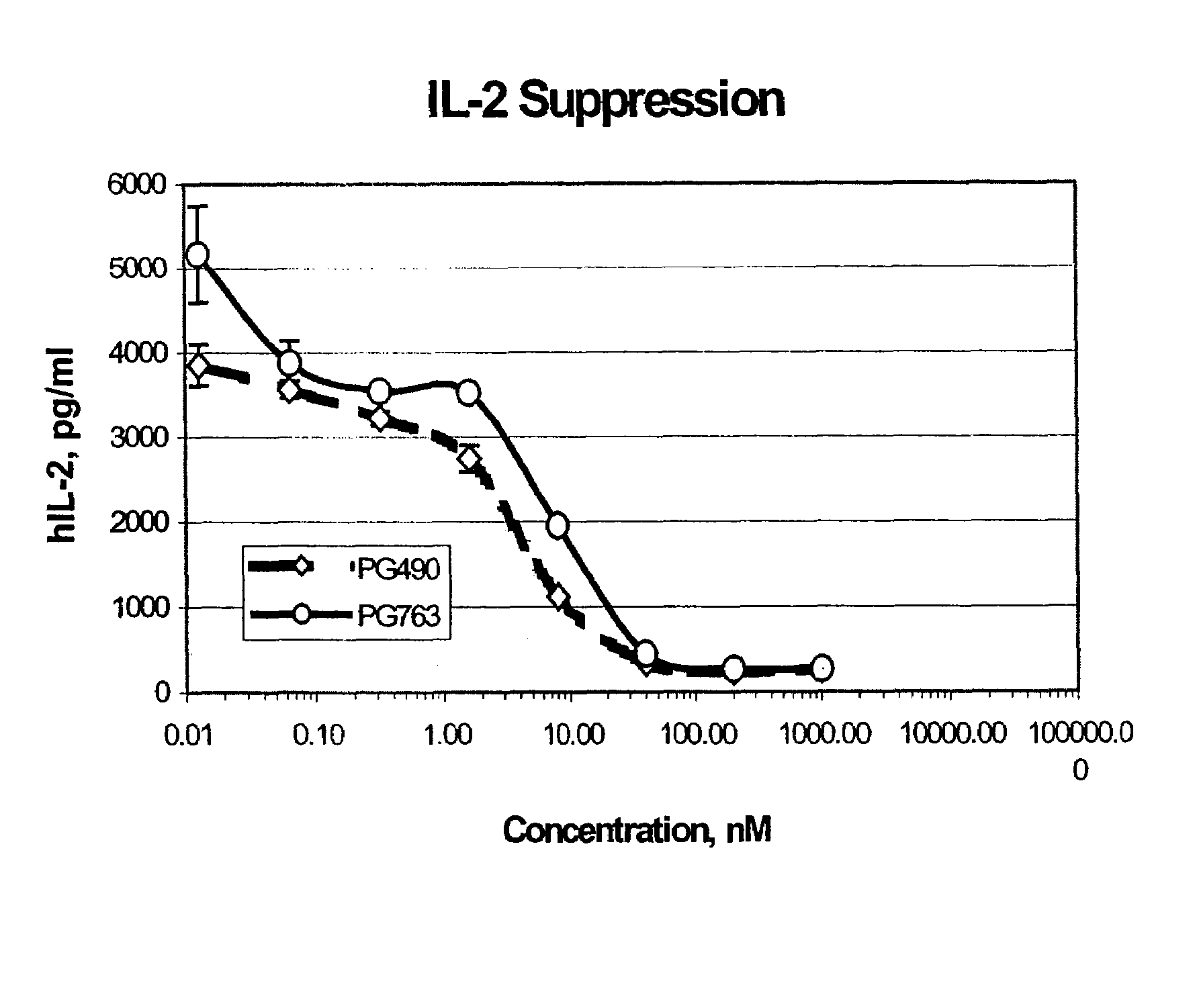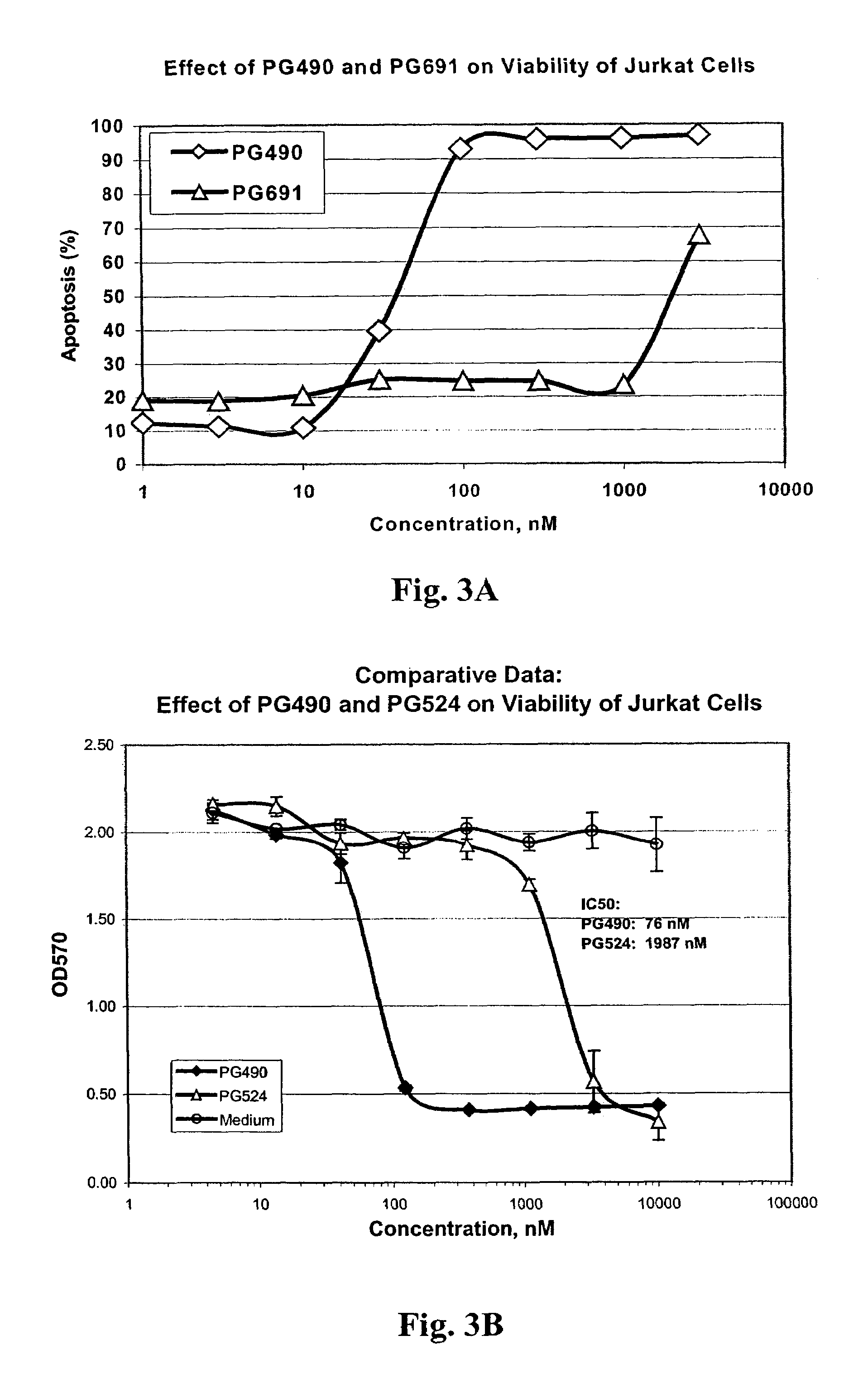Halogenated triptolide derivatives as immunomodulators and anticancer agents
a technology of immunomodulators and triptolide derivatives, applied in the field of compounds useful as immunomodulators, antiinflammatory and anticancer agents, can solve the problems of significant toxic to the kidney, limited use of cyclosporin a, and inability to completely eliminate the effect of these drugs
- Summary
- Abstract
- Description
- Claims
- Application Information
AI Technical Summary
Benefits of technology
Problems solved by technology
Method used
Image
Examples
example 1
Preparation of 14-deoxy-14α-fluorotriptolide
[0129]
[0130]To a solution of PG490 (triptolide, 17.3 mg, 0.048 mmol) in dichloromethane (1.0 ml) at 0° C. was added (diethylamino)sulfur trifluoride (DAST, 100 μl, 0.763 mmol) under N2. The reaction mixture was stirred at 0° C. for 2 hrs, and saturated NaHCO3 solution (0.8 ml) was then added. The reaction mixture was extracted with 3×2 ml of dichloromethane. The combined organic layer was dried over anhydrous NaSO4 and concentrated under vacuum. The desired product (PG763) was obtained in quantitative yield.
[0131]Analytical TLC Rf=0.78 (ethyl acetate / hexanes / methanol 1:1:0.1). IR (KBr): 3031.0, 2961.2, 2942.4, 2873.8, 1764.6, 1680.9, 1449.3, 1438.3, 1172.2, 1098.1, 1074.5, 1057.0, 1047.1, 1034.2, 1018.2, 1005.6, 987.3, 972.3, 923.9, 909.0, 743.6, 586.0, 566.0, 539.8, 527.6 cm−1. 1HNMR (300 MHz, CDCl3): δ=5.16 (d, 1H, 14-CH), 4.70 (q, 2H, 19-CH2), 3.80 (d, 1H, 11-CH), 3.73 (d, 1H, 7-CH), 3.50 (t, 1H, 12-CH), 2.70 (m, 1H, 5-CH), 2.34 (d, 1H,...
example 2
Cytotoxicity (MTT) Assay
[0132]Test compounds were dissolved in DMSO at a concentration of 20 mM. Further dilutions were done in RPMI 1640 medium (GIBCO, Rockville, Md.) supplemented with 10% Fetal Calf Serum (HyClone Laboratories, Logan, Utah).
[0133]Cytotoxicity of the compounds was determined in a standard MTT assay using Cell Proliferation Kit I (#1 465 007, Roche Diagnostics, Mannheim, Germany). Briefly, human T cell lymphoma (Jurkat) cells (4×105 per well) were cultured for 24 h, in 96-well tissue culture plates, in the presence of serial three-fold dilutions of test compounds or medium containing the same concentration of DMSO as in the test samples at each dilution point. The cultures were then supplemented with 10 μl / well MTT reagent for 4h and then with 0.1 ml / well solubilizing reagent for an additional 16 h. Optical density at 570 nm (OD570) was measured on a ThermoScan™ microplate reader (Molecular Devices, Menlo Park, Calif.). The data is presented as OD570 values versus ...
example 3
[0134]Test samples were diluted to 1 mM in complete tissue culture medium (RPMI 1640 medium plus 5% heat-inactivated fetal calf serum, 1% HEPES, 1% pen / strep, 1% glutamine). Aliquots were placed in microculture plates and serial dilutions were prepared so that the final concentration would encompass the range of 2 to 6,000 nM with half-log increments. Cells from an exponentially expanding culture of the Jurkat human T lymphoma cell line (#TIB-152 obtained from American Type Culture Collection, Manassas, Va.) were harvested, washed once by centrifugation, re-suspended in complete tissue culture medium, and further diluted to a concentration of 1×106 cells / ml. A volume of 100 μl of the cells (1×105 cells) was added to wells containing 100 μl of the diluted compounds, and the plates were incubated at 37° C. in a 5% CO2 incubator.
[0135]After 24 hours, the plates were centrifuged to pellet the cells, and the cells were washed twice with 2% heat-inactivated fetal...
PUM
 Login to View More
Login to View More Abstract
Description
Claims
Application Information
 Login to View More
Login to View More - R&D
- Intellectual Property
- Life Sciences
- Materials
- Tech Scout
- Unparalleled Data Quality
- Higher Quality Content
- 60% Fewer Hallucinations
Browse by: Latest US Patents, China's latest patents, Technical Efficacy Thesaurus, Application Domain, Technology Topic, Popular Technical Reports.
© 2025 PatSnap. All rights reserved.Legal|Privacy policy|Modern Slavery Act Transparency Statement|Sitemap|About US| Contact US: help@patsnap.com



